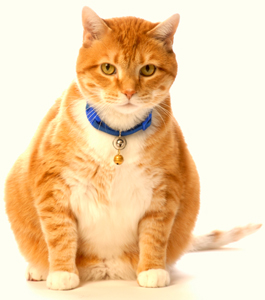The Diabetic Cat
Diabetes is a condition caused by a relative resistance to or deficiency of insulin which results in elevated blood glucose levels and glucose in the urine. Diabetes mellitus is most common in older cats; however, obese cats are at an increased risk of developing this condition. Evidence has shown that genetics may play a role in the development of diabetes in cats. In particular, the Burmese breed has been identified as being predisposed to diabetes, and analysis of pedigrees has suggested that this is an inherited trait.
Insulin is produced by the pancreas and is released into the bloodstream where it travels to all the tissues of the body. Its main role is to enable cells to take up glucose (sugar) which is needed as an energy source. In diabetes, there is a relative or absolute deficiency of insulin. An absolute insulin deficiency may arise as a direct failure of the pancreas to produce this hormone. In most diabetic cats, there is both an absolute insulin deficiency and a situation whereby cells of the body fail to respond effectively to the insulin produced. This results in a decreased amount of glucose taken up by the cells and an increase of glucose in the blood (called hyperglycemia). As the cells are starved of glucose, the body begins to break down stored fats and proteins for sources of energy. This process results in weight loss and the accumulation of toxic waste products, which can cause a diabetic crisis known as ketoacidosis.
The symptoms of diabetes may be severe or mild. Due to the increased amount of glucose in the blood, it is excreted into the urine. Glucose that is passed into the urine takes water with it, so an increased volume of urine is produced. To compensate for the water lost into the urine, diabetic cats develop an increased thirst. Weight loss and an increased appetite are also frequently seen.

The cat owner often reports one or several of the following symptoms:
• Weight loss
• Increased appetite
• Increased urination
• Increased water consumption
These signs are not always present or may pass unnoticed. If a cat spends most of his or her time outdoors, the increased thirst and increased urination may not be noticed by the owner.
There are other clinical signs that may be observed. These include:
• Straining to pass urine or passing bloody urine (associated with a urinary tract infection)
• Poor coat
• Cataracts and retinal abnormalities causing vision problems
• Weakness in hind legs or dropped hocks
Some cats develop ketoacidosis, a complication in uncontrolled diabetes. In this situation, the cat may become extremely depressed, with symptoms such as vomiting, diarrhea, complete loss of appetite, dehydration, collapse and coma. If any of these signs are seen in a diabetic cat, it is an emergency condition and he or she should be taken to a veterinary hospital immediately.
Diabetes mellitus is usually a treatable condition, but requires considerable dedication and commitment from the cat’s owners. Owners of a diabetic cat need to be aware that a strict routine must be followed. The timing of insulin injections is important; however, they can be altered to suit the lifestyle of the owner. Once the insulin injections have begun, they need to be given at regular intervals. Knowledge on correct insulin storage, handling and administration is also required. The dose of insulin given should never be changed without consulting your veterinarian. One of the most common reasons for poor stabilization at home is problems with insulin storage and/or administration.
If you feel that your cat shows symptoms of diabetes, it is best to have him or her examined by a veterinarian at Mandarin Animal Hospital as soon as possible. The earlier that diabetes is diagnosed and brought under control, the easier it is to manage.